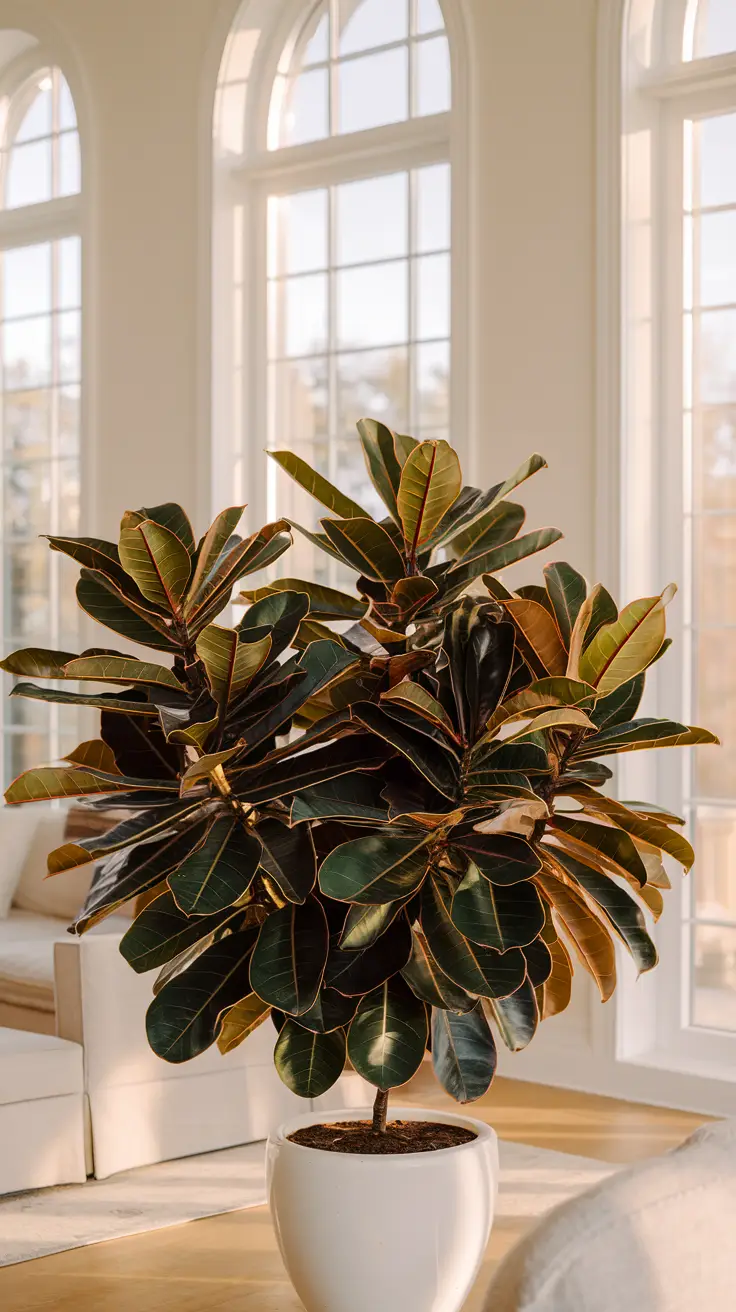Biological Features of Ficus Umbellata
The Ficus Umbellata is a unique plant known for its distinctive characteristics. It belongs to the Moraceae family, showcasing glossy, dark green leaves that are oval to lanceolate in shape. This species typically grows as a shrub or small tree, reaching heights of 10 to 20 feet.
Leaf and Stem Structure
The leaves of Ficus Umbellata can reach up to 8 inches in length. The leaf arrangement is alternate, and each leaf has a prominent midrib, adding to its texture. The stem is sturdy and often exudes a milky latex when cut, a common feature in the Ficus genus.
Reproductive Traits
This plant is dioecious, meaning individual plants are either male or female. The male flowers produce pollen, while the female flowers develop into an edible fruit called a syconium. These fruits are small, pear-shaped, and grow in clusters. They typically ripen in late summer to early fall, attracting a variety of birds and insects.
Growth Conditions
The Ficus Umbellata thrives in tropical and subtropical climates. It prefers well-draining soil and can tolerate a range of pH levels, ideally between 6 and 7. Adequate light is essential; however, it can adapt to partial shade. Regular watering promotes healthy growth, but overwatering should be avoided. Indoor plants should receive indirect sunlight to flourish.
| Feature | Details |
|---|---|
| Family | Moraceae |
| Height | 10 to 20 feet |
| Leaf Size | Up to 8 inches |
| Fruit Type | Syconium |
| Ideal Soil pH | 6 to 7 |

History and Cultural Significance
Ficus Umbellata has a rich history in various cultures. The plant is native to tropical regions of Africa and parts of Asia. Historically, it has been valued for its shade and ornamental beauty. As a member of the Ficus family, it contributes significantly to ecological balance.
Traditional Uses
In many cultures, Ficus Umbellata fulfills various traditional roles. Its leaves are often utilized in local crafts. Additionally, communities cherish it for its medicinal properties.
- Medicinal Uses: The sap is sometimes used as a natural remedy for skin ailments.
- Craft Materials: The fibrous parts are employed to create durable materials.
- Shade Provider: Many people plant it in gardens for its extensive coverage.
Symbolism
This species holds symbolism in several cultures. It often represents resilience and longevity. The Ficus Umbellata is also seen as a symbol of growth due to its ability to thrive in various environments. Furthermore, its lush foliage is appreciated for enhancing outdoor spaces.
Overall, Ficus Umbellata embodies more than just an ornamental plant. Its contributions to culture and the environment highlight its importance. Appreciating its history helps us understand its role today.

Ideal Growing Conditions for Ficus Umbellata
The Ficus Umbellata thrives in specific conditions that enhance its growth and health. Understanding these conditions is key for any grower. This plant enjoys a warm climate and prefers temperatures between 65°F to 80°F (18°C to 27°C).
It also likes moderate humidity levels, ideally around 50%. If you can provide these atmospheric conditions, your Ficus Umbellata will flourish. Light requirements are crucial too. This plant prefers bright, indirect sunlight. Direct sunlight can scorch its leaves, so keep it well-lit but sheltered.
Watering and Soil Requirements
Watering is important for the health of your Ficus Umbellata. Maintain consistently moist soil but avoid waterlogging. It’s vital to let the top inch of soil dry out before watering again. Overwatering can lead to root rot, which may endanger your plant.
As for soil, a well-draining potting mix is best. Organic potting soil, mixed with perlite, provides the right texture and drainage. This helps to prevent water accumulation, which is detrimental to root health.
Pest and Disease Management
Pests can affect your Ficus Umbellata if you do not monitor it closely. Regularly check for common pests like spider mites and mealybugs. If found, treat your plant with insecticidal soap or neem oil.
Moreover, maintaining proper humidity can help prevent pests. A healthy plant is more resistant to disease. Regularly inspect leaves for discoloration or spots as these can indicate issues. Early detection and treatment are vital in managing any potential diseases.
Table of Ideal Conditions
| Condition | Ideal Level |
|---|---|
| Temperature | 65°F – 80°F |
| Humidity | 50% |
| Light | Bright, indirect sunlight |
| Soil Type | Well-draining potting mix |
| Watering | Moist but not soggy |

Plant Care and Maintenance
Proper care and maintenance are essential for the health of your Ficus Umbellata. This tropical plant thrives in specific conditions that support its growth. Start by ensuring it receives the right amount of light. Preferably, place it in a spot with bright, indirect sunlight to prevent leaf scorch. Too little light can cause stunted growth and leaf drop. Secondly, regulate watering to maintain soil moisture.
Watering Needs
The Ficus Umbellata needs consistent watering. Allow the top inch of soil to dry before watering again. Overwatering can lead to root rot, so ensure that the pot has good drainage. Use a potting mix that retains moisture while allowing excess water to escape. It’s best to use a pot with drainage holes.
Humidity and Temperature
This plant enjoys higher humidity levels. If your home is dry, consider using a humidifier or placing a tray of water near it. Ideal temperatures range from 60°F to 85°F (15°C to 29°C). Avoid exposing the plant to cold drafts or sudden temperature changes.
Fertilizing Your Ficus
Fertilization plays a key role in its growth. During the growing season, feed the Ficus Umbellata with a balanced liquid fertilizer every four to six weeks. Reduce feeding during the dormant season in winter.
Pest Control
Inspect your plant regularly for pests. Common pests for Ficus include spider mites and scale. If you notice an infestation, use insecticidal soap or neem oil. Always test any treatment on a small leaf first to ensure it doesn’t harm the plant.
Pruning and Repotting
Regular pruning helps maintain its shape and promotes bushier growth. Trim back any dead or yellowing leaves as needed. For repotting, do it every couple of years or when rootbound. Choose a pot that is one size larger to allow for growth.
Signs of Stress
If you observe yellowing leaves or leaf drop, it may indicate stress. This could be due to over or underwatering, low light, or temperature fluctuations. Adjusting care routines can help revive your Ficus Umbellata.
- Provide bright, indirect light.
- Water consistently, allowing soil to dry slightly.
- Maintain humidity and moderate temperatures.
- Fertilize during the growing season.
- Check regularly for pests.
By adhering to these care practices, your Ficus Umbellata can thrive and add beauty to your space.
Propagation Techniques for Ficus Umbellata
Propagation is crucial for expanding your collection of Ficus Umbellata. This process ensures the health of the plant while providing new specimens for gardening enthusiasts. There are several effective methods to propagate Ficus Umbellata, each with its own benefits.
One of the most common techniques is through stem cuttings. To do this, cut a healthy stem from the parent plant, ensuring it has several leaves. Trim the cutting to about six inches long. Remove the lower leaves to expose the nodes. Nodes are essential as they will develop roots.
Rooting the Cuttings
Next, place the cut end in water or a potting mix. If using water, ensure the nodes are submerged for the best results. Change the water every few days to prevent stagnation. If employing potting mix, keep it lightly moist but not waterlogged.
Patience is key; it typically takes a few weeks for roots to develop. Once the roots are several inches long, transplant the cutting to a larger pot. Always opt for a well-draining soil mix to promote further growth.
Layering Method
Another propagation method is layering. This involves bending a low branch of the Ficus Umbellata to touch the soil while it remains attached to the parent plant. Cover the section touching the soil with a small amount of dirt, ensuring it stays moist. In time, the buried part will develop roots. Once this is complete, sever the new plant from the parent.
Regardless of the method chosen for your Ficus Umbellata, all successful propagations require the right environment. Ensure adequate light without direct sunlight, as harsh rays can damage the young plants. Maintaining a humid environment also supports healthy growth.
Common Problems and Solutions
The Ficus Umbellata, while generally hardy, can face several issues. Recognizing these problems early can help you maintain a healthy plant. Here are some common problems and solutions for your Ficus Umbellata.
1. Leaf Drop
Leaf drop is a frequent concern for Ficus Umbellata owners. It often occurs due to stress factors such as overwatering, underwatering, or sudden changes in environment. Ensure a consistent watering routine. Moreover, avoid placing your plant in drafty areas.
2. Pests
Pests can invade your Ficus Umbellata. Common pests include spider mites, mealybugs, and scale. Regularly inspect the leaves for signs of infestation.
- Treat spider mites with insecticidal soap or neem oil.
- For mealybugs, use a cotton swab dipped in alcohol to wipe them off.
- If scale is present, consider using horticultural oil.
3. Yellowing Leaves
Another common issue is yellowing leaves. This often signifies either overwatering or nutrient deficiencies. Check the soil moisture; it should be slightly moist, not soggy. If you suspect a nutrient deficiency, consider using a balanced fertilizer once a month during the growing season.
4. Brown Leaf Tips
Browning leaf tips may indicate low humidity or inadequate watering. Ficus Umbellata prefers humidity levels above 50%. To increase humidity, you can mist the leaves regularly or use a pebble tray with water.
5. Stunted Growth
Stunted growth can occur due to insufficient light. Ficus Umbellata thrives in bright, indirect sunlight. If your plant isn’t getting enough light, consider moving it closer to a window or supplementing with grow lights.
| Problem | Solution |
|---|---|
| Leaf Drop | Ensure proper watering; avoid drafts. |
| Pests | Treat with insecticidal soap or neem oil. |
| Yellowing Leaves | Check soil moisture; fertilize if necessary. |
| Brown Leaf Tips | Increase humidity; mist leaves regularly. |
| Stunted Growth | Provide bright, indirect sunlight. |
By addressing these common issues, you can enjoy a thriving Ficus Umbellata for years to come. Regular care and observation are key to preventing many of these problems.
Seasonal Care Adjustments
Ficus Umbellata thrives well with seasonal care adjustments. Proper care changes throughout the year can enhance its growth and health. During spring and summer, increase watering frequency as the plant grows actively. Conversely, reduce watering in fall and winter when growth slows down.
Temperature and Humidity
Maintain a temperature of 60-75°F (15-24°C) for optimal growth. In addition, Ficus Umbellata prefers humidity levels around 50-60%. To achieve this:
- Use a humidifier, especially in dry months.
- Group plants together to create a microclimate.
- Regularly mist the leaves to boost humidity.
Fertilization Tips
During the growing season, fertilize your Ficus Umbellata every 4-6 weeks. Choose a balanced houseplant fertilizer. In fall and winter, cut back on fertilization as the plant’s needs decrease. Also, ensure the soil drains well to avoid waterlogging.
Microclimate Setup Tips
Creating the perfect microclimate for your Ficus Umbellata requires careful consideration of several factors. Firstly, lighting plays a crucial role. Ideally, place your Ficus Umbellata in bright, indirect sunlight. Too much direct sunlight can scorch the leaves.
Temperature and Humidity
The temperature should be consistently warm, ideally between 65°F to 80°F (18°C to 27°C). Ficus Umbellata thrives in high humidity levels, generally above 50%. A humidifier can help maintain the required moisture levels.
Air Circulation
Good air circulation is essential. While Ficus Umbellata prefers still air, providing a gentle breeze will help prevent stagnant moisture, which can lead to fungal issues. If necessary, use a small fan to improve airflow.
Watering and Soil
Watering is another critical component. Ensure the soil remains slightly moist but not soggy. Allow the top inch of soil to dry out before watering again. A well-draining potting mix is ideal for this plant.
Fertilizing
During the growing season, feed your Ficus Umbellata with a balanced, water-soluble fertilizer. This will promote healthy growth and vibrant foliage.
Protection from Pests
Lastly, be vigilant about pest control. Regularly inspect your Ficus Umbellata for signs of pests like spider mites and aphids. Quick action can save your plant from serious damage.
- Ensure bright, indirect sunlight.
- Maintain temperatures between 65°F to 80°F.
- Keep humidity above 50%.
- Use well-draining soil.
- Feed with balanced fertilizer during growth.
Frequently Asked Questions
The Ficus Umbellata is a popular choice among plant enthusiasts due to its unique characteristics. People often ask about its care requirements. One common question is regarding its light preferences. This plant thrives in bright, indirect sunlight. However, too much direct light may scorch its leaves.
Another frequently asked question pertains to watering. The Ficus Umbellata should be watered when the top inch of soil feels dry. Overwatering can lead to root rot, so it’s important to ensure proper drainage. Moreover, many individuals wonder about its growth rate. This plant grows moderately fast under optimal conditions, making it an exciting addition to home decor.
Additionally, pests are a concern for many plant owners. The Ficus Umbellata can attract spider mites and scale. Regularly inspecting the leaves can help catch any infestations early. Fertilization is another topic that arises. Using a balanced liquid fertilizer every month during the growing season can support vibrant growth.
Finally, some wonder if pruning is necessary. Pruning can help maintain its shape and promote bushier growth. Overall, understanding these factors enhances the enjoyment of owning a Ficus Umbellata.
Summary and Recommendations
The Ficus Umbellata is a captivating indoor plant known for its lush green leaves and sturdy structure. This species thrives in bright, indirect light. Besides, it prefers humidity, making it ideal for bathrooms or kitchens. Water this plant thoroughly but allow the soil to dry slightly between waterings.
For optimum growth, consider using a well-draining potting mix. Fertilize every month during the growing season with diluted liquid fertilizer. Additionally, regularly dust the leaves to enhance its appearance and health. This will help the plant use sunlight more efficiently.
When it comes to pests, keep an eye out for common nuisances like spider mites. If infested, use insecticidal soap or natural remedies. Overall, the Ficus Umbellata is easy to care for and makes a stunning addition to any space.






